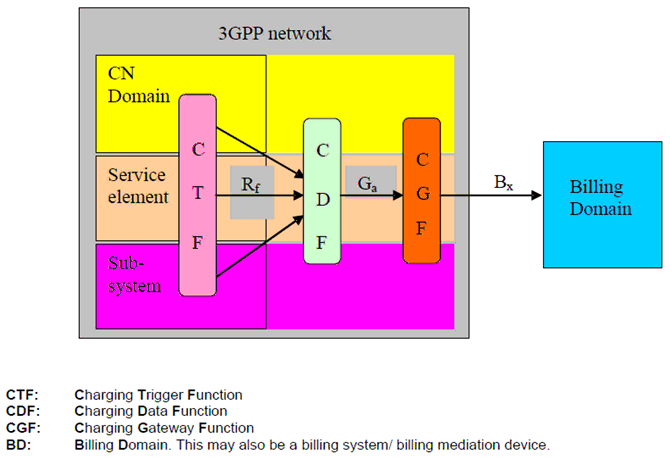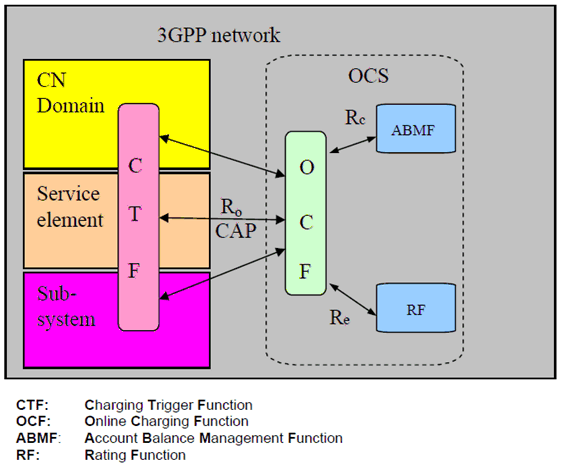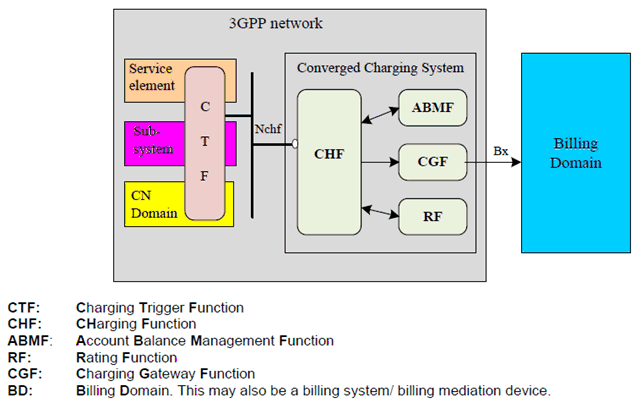Content for TS 32.240 Word version: 19.0.0
4.3 Charging functions
4.3.1 Offline charging functions
4.3.1.0 General
4.3.1.1 Charging Trigger Function
4.3.1.2 Charging Data Function
4.3.1.3 Charging Gateway Function
4.3.1.4 Offline Charging System
4.3.2 Online charging functions
4.3.2.0 General
4.3.2.1 Charging Trigger Function
4.3.2.2 Online Charging System
4.3.2.3 CDR generation for online charged subscribers
4.3.3 Converged charging functions
4.3.3.0 General
4.3.3.1 Charging Trigger Function (CTF)
4.3.3.2 Converged Charging System (CCS)
4.3.3.3 Charging Enablement Function (CEF)
...
...
4.3 Charging functions p. 31
4.3.1 Offline charging functions p. 31
4.3.1.0 General |R12| p. 31
Figure 4.3.1.0.1 provides an overview of the offline part of the common charging architecture of Figure 4.2.2.1. The Figure 4.3.1.0.1 depicts the logical charging functions as well as the reference points between these functions and to the BD.

4.3.1.1 Charging Trigger Function p. 31
The Charging Trigger Function (CTF) generates charging events based on the observation of network resource usage as described in clause 4.1.1. In every network element and service element that provides charging information, the CTF is the focal point for collecting the information pertaining to chargeable events within the network element, assembling this information into matching charging events, and sending these charging events towards the CDF. The CTF is therefore a mandatory, integrated component in all network elements that provide offline charging functionality, as depicted in Figure 4.2.2.1. It is made up of two functional blocks:
-
Accounting Metrics Collection
The process that monitors signalling functions for calls, service events or sessions established by the network users, or the handling of user traffic for these calls, service events or sessions, or service delivery to the user via these calls, service events or sessions. It is required to provide metrics that identify the user and the user's consumption of network resources and/or services in real-time. The exact behaviour and functionality of this process e.g.:
- trigger conditions for collection of charging information,
- information elements to collect,
- which service events, signalling or user traffic to monitor,
- relationship to services / bearers / sessions,
- Accounting Data Forwarding This process receives the collected accounting metrics and determines the occurrence of chargeable events from a set of one or more of these metrics. It then assembles charging events that match the detected chargeable events, and forwards the charging events towards the CDF via the Rf reference point. The charging events provide information pertinent to the chargeable event, i.e. characterising the network resource usage together with an identification of the involved user(s). There is no assumption of any synchronisation between the reception of individual accounting metrics, however, it must be possible for the Accounting Data Forwarding to complete its overall functionality per charging event in real-time. While the exact information received by the Account Data Forwarding from the Account Metrics Collection, and the relevant chargeable events, are specific to each type of network element, the overall functionality of receiving, assembling and forwarding the charging information can be considered generic. Hence the Accounting Data Forwarding is considered the NE independent part of the CTF.
4.3.1.2 Charging Data Function p. 33
The Charging Data Function (CDF) receives charging events from the CTF via the Rf reference point. It then uses the information contained in the charging events to construct CDRs. This procedure is characterised by the following conditions:
- CDRs may be constructed from single charging events, i.e. a 1:1 relation between event and CDR.
- CDRs may be constructed from a set of several charging events, i.e. a n:1 relation between event and CDR.
- Each charging event is used for exactly one CDR, i.e. a 1:n relation between event and CDR (with n>1) is not possible.
- Multiple charging events that are used to create a single CDR may not necessarily be of the same type.
- There is no requirement or assumption of any synchronisation between the reception of the charging event(s) and the creation of the resulting CDR. However, the CDF shall be capable of receiving and processing charging events and generating the resulting CDR in near real-time.
- The relationship between CDF and CTF may be 1:1 (integrated CDF) or 1:n (separated CDF) (refer to clause 4.5 for possible physical configurations of the logical charging functions). This includes the possibility of NEs of different types feeding charging events into the same CDF.
- All charging events used to build a CDR must originate from the same NE, i.e. there is no cross-NE or cross-NE-type correlation of charging events in the CDF.
4.3.1.3 Charging Gateway Function p. 33
The CDRs produced by the CDF are transferred immediately to the Charging Gateway Function (CGF) via the Ga reference point. The CGF acts as a gateway between the 3GPP network and the BD. It uses the Bx reference point for the transfer of CDR files to the BD. The entity relationship between the CDF and the CGF is m:1, i.e. one or more CDFs may feed CDRs into a single CGF. The CGF comprises the following main functions:
- CDR reception from the CDF via the Ga reference point in near real-time. The protocols that may cross the Ga reference point are specified in TS 32.295.
-
CDR pre-processing:
- Validation, Consolidation and (Re-) Formatting of CDRs.
- CDR error handling.
- Persistent CDR storage.
- CDR routing and filtering, i.e. storing CDRs on separate files based on filtering criteria such as CDR type, CDR parameters, originating CDF, etc.
- CDR File Management, e.g. file creation, file opening / closure triggers, file deletion.
- CDR file transfer to the BD.
4.3.1.4 Offline Charging System |R11| p. 33
The Offline Charging System (OFCS) is a grouping of charging functions used for offline charging. It collects and processes charging events from one or more CTFs, and it generates CDRs for subsequent offline downstream billing processes.
4.3.2 Online charging functions p. 34
4.3.2.0 General |R12| p. 34
Figure 4.3.2.0.1 provides an overview of the online part of the common charging architecture of Figure 4.2.2.1. The Figure 4.3.2.0.1 depicts the logical charging functions in the network and the OCS and the reference points between these functions.

4.3.2.1 Charging Trigger Function p. 34
As outlined in clause 4.1.2, online charging is a process where charging information is collected in the network element in the same fashion as in offline charging. This implies that, from the functional perspective, the CTF defined in clause 4.3.1.1, also creates the charging events used for online charging. While the accounting metrics used in online charging are generally the same as in offline charging (i.e. the charging mechanism is transparent to the Accounting Metrics Collection), the following functional enhancements concerning the Accounting Data Forwarding are required in the CTF in order to support online charging:
- The information collected for, and included in, the online charging events is not necessarily identical to the offline charging case (i.e. the chargeable events may not necessarily be identical to those observed in offline charging);
- The charging events are forwarded to the Online Charging Function (OCF) in order to obtain authorisation for the chargeable event / network resource usage requested by the user;
- The CTF must be able to delay the actual resource usage until permission by the OCS has been granted;
- The CTF must be able to track the availability of resource usage permission ("quota supervision") during the network resource usage;
- The CTF must be able to enforce termination of the end user's network resource usage when permission by the OCS is not granted or expires.
4.3.2.2 Online Charging System p. 35
4.3.2.2.0 General |R12| p. 35
The following sub-clauses summarise the tasks of the functions comprising the OCS. Details of the OCS, and the role of each of its functional components, are described in TS 32.296.
4.3.2.2.1 Online Charging Function p. 35
The OCF consists of two distinct modules, namely the Session Based Charging Function (SBCF) and the Event Based Charging Function (EBCF).
The Session Based Charging Function is responsible for online charging of network / user sessions, e.g. voice calls, IP CAN bearers, IP CAN session or IMS sessions.
The Event Based Charging Function performs event-based online charging (also referred to as "content charging") in conjunction with any application server or service NE, including SIP application servers.
Online charging in the CS and PS domains may be performed using the CAP reference point from the MSC and SGSN, respectively, to the OCF (refer to TS 23.078 for details on CAP). Online charging communication between the S-CSCF and the SBCF is described in clause 4.3.2.2.2. All other network elements employ the Ro reference point for online charging (refer to TS 32.299). Refer to TS 32.296 for details on the relation between the network elements (i.e. the embedded online enhanced CTF) and the SBCF or EBCF, respectively.
4.3.2.2.2 S-CSCF online charging / IMS Gateway Function p. 35
As stated above, the S-CSCF does not trigger any online charging events and thus does not include the CTF online charging enhancements described in clause 4.3.2.1 (in contrast, it does have a CTF for offline charging, as described in clause 4.3.1.1). Instead, the ISC interface is employed by the S-CSCF online charging, implying that online charging is transparent to the S-CSCF and appears like any other service logic controlled by a SIP application server. Therefore, if support for Ro based online charging is required instead of / or in addition to application server or MRFC, a special CTF is needed in order to mediate between the Ro based SBCF and the SIP based service control. This role is taken by the IMS Gateway Function (IMS GWF), which translates between SIP service control towards the S-CSCF and Ro Credit-Control on the OCS side.
From the perspective of the online charging architecture, the IMS GWF is an online charging capable CTF; from the perspective of the S-CSCF, the IMS GWF is a SIP application server and is triggered the same way. It is out of scope of the 3GPP standards whether the IMS GWF is embedded in the S-CSCF, embedded in the OCS/SBCF, or exists as a stand-alone component.
4.3.2.2.3 Rating Function p. 35
The Rating Function (RF) determines the value of the network resource usage (described in the charging event received by the OCF from the network) on behalf of the OCF. To this end, the OCF furnishes the necessary information, obtained from the charging event, to the RF and receives in return the rating output (monetary or non-monetary units), via the Re reference point. The RF may handle a wide variety of rateable instances, such as:
- Rating of data volume (e.g. based on charging initiated by an access network entity, i.e. on the bearer level);
- Rating of session / connection time (e.g. based on charging initiated by a SIP application, i.e. on the subsystem level);
- Rating of service events (e.g. based on charging of web content or MMS, i.e. on the service level).
4.3.2.2.4 Account Balance Management Function p. 36
The Account Balance Management Function (ABMF) is the location of the subscriber's account balance within the OCS or the CCS. The ABMF is put into functional context within TS 32.296.
4.3.2.3 CDR generation for online charged subscribers p. 36
In offline charging, CDRs are generated in the network and forwarded to the BD for further processing, e.g. generating subscriber bills. In online charging, network resource usage is granted by the OCS based on a subscriber account on the OCS. If required by the operator, CDRs may additionally be generated for online charged subscribers. One way of achieving this is by performing online charging and offline charging simultaneously for these subscribers. Alternatively, the OCS can accomplish this by the use of the appropriate offline charging functions as follows:
- A CDF, as specified in clause 4.3.1.2, is employed by each of the OCFs that are required to generate CDRs from the charging events they receive from the CTF;
- A CGF, as specified in clause 4.3.1.3, is employed by the OCS in order to generate / manage CDR files and provide these files to the BD.
4.3.3 Converged charging functions |R15| p. 36
4.3.3.0 General p. 36
Figure 4.3.3.0.1 provides an overview of converged charging architecture. The Figure 4.3.3.0.1 depicts the logical charging functions in the network and interface between these functions and to the BD.
This charging architecture is used for 5G system.

Figure 4.3.3.0.1: Logical ubiquitous converged charging architecture
(⇒ copy of original 3GPP image)
(⇒ copy of original 3GPP image)
4.3.3.1 Charging Trigger Function (CTF) p. 36
The Charging Trigger Function (CTF) interacts with the Charging Function (CHF) of the Converged Charging System (CCS) using Nchf interface for consuming CHF services as defined in TS 32.290:
-
converged charging (Nchf_
ConvergedCharging service) wich operates: - with quota management (online charging);
- without quota management (offline charging);
-
offline only charging (Nchf_
OfflineOnlyCharging service).
4.3.3.2 Converged Charging System (CCS) p. 37
4.3.3.2.0 General |R16| p. 37
The Converged Charging System (CCS) consists of four distinct modules, namely the CHF, the Account Balance Management Function (ABMF), the Charging Gateway Function (CGF) and the Rating Function (RF).
The converged charging system interacts with CTF using Nchf interface and interacts with the BD using Bx interface.
4.3.3.2.1 Charging Function (CHF) |R16| p. 37
The CHF includes:
- Online Charging Function (OCF) specified in TS 32.296, providing quota management functionality under Credit-Control terminology.
- Charging Data Function (CDF) specified in clause 4.3.1.2, providing CDRs generation functionality for charging events received from the CTF or CEF via Nchf.
4.3.3.2.2 Account Balance Management Function (ABMF) |R16| p. 37
The ABMF is described in clause 4.3.2.2.4.
4.3.3.2.3 Rating Function (RF) |R16| p. 37
The Rating Function (RF) is described in clause 4.3.2.2.3.
4.3.3.2.4 Charging Gateway Function (CGF) |R16| p. 37
The Charging Gateway Function (CGF) is described in clause 4.3.1.3.
4.3.3.3 Charging Enablement Function (CEF) |R16| p. 37
The Charging Enablement Function (CEF) is a consumer of Nchf charging services, and for the purpose of charging information collection may consume management services, services exposed by other network functions or both.